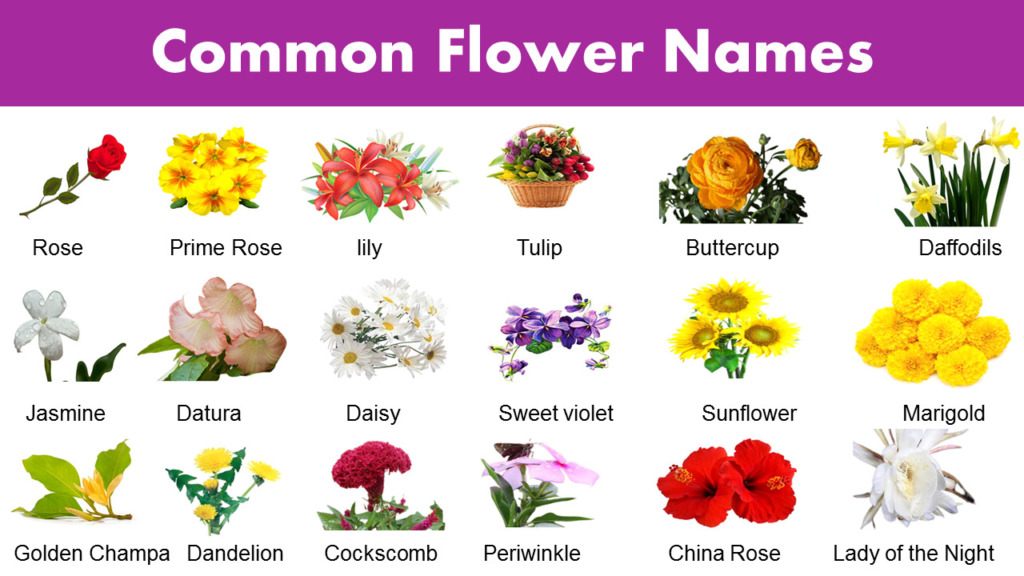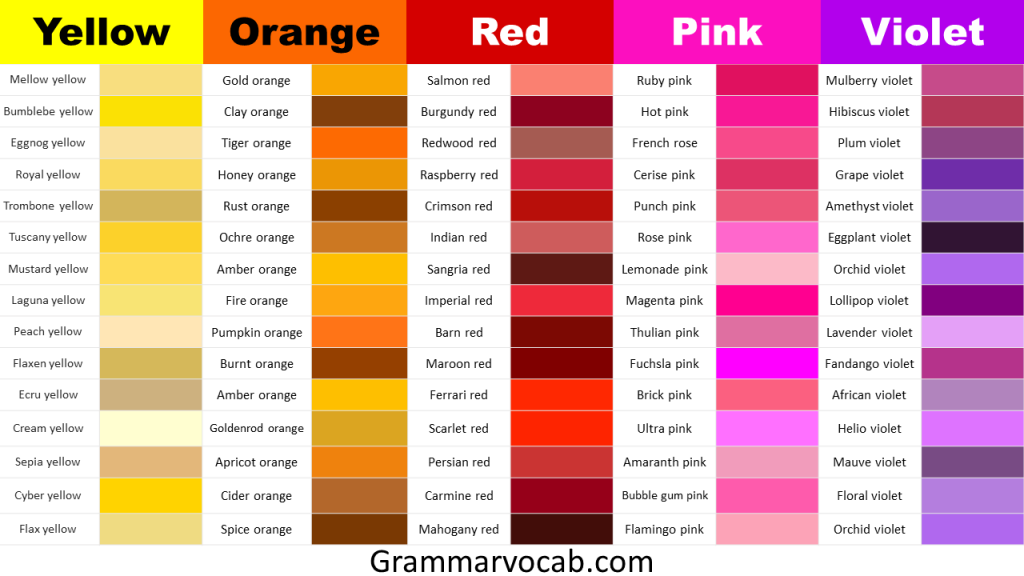If you’re someone who works with tools, either professionally or as a hobbyist, you know the importance of having the right tools for the job. From simple hand tools like screwdrivers and pliers to more complex power tools like saws and drills, having a well-stocked toolbox can make all the difference in the success of your projects. But with so many different types of tools out there, it can be overwhelming to know which ones to invest in. That’s why we’ve compiled a comprehensive list of tool names to help you identify and familiarize yourself with the different tools available to you. Whether you’re a seasoned professional or just starting out, this list will provide you with a wealth of knowledge on the tools of the trade.
Electrical Tools Name
Oscilloscope – An instrument used to observe and analyze the waveform of electrical signals.
Power Drill – A handheld tool used for drilling holes in various materials.
Wire Stripper – A tool used to remove the insulation from electrical wires.
Crimping Tool – A device used to join two pieces of metal or other materials by deforming one or both of them to hold the other.
Pliers – A hand tool with opposing jaws used for gripping, bending, or cutting various materials.
Voltage Tester – A device used to test for the presence of electrical current in a circuit.
Circuit Breaker Finder – A tool used to locate the correct circuit breaker in a panel box.
Insulation Tester – A device used to test the insulation resistance of electrical wires and components.
Heat Gun – A tool used to heat and soften materials for shaping, welding, or removing paint.
Soldering Iron – A device used to join two pieces of metal by melting and flowing a filler metal into the joint.
Wire Crimper – A tool used to crimp electrical connectors onto the end of wires.
Cable Tie Gun – A device used to tighten and cut cable ties.
Electrical Tape – A type of adhesive tape used to insulate and protect electrical wires and components.
Wire Cutter – A tool used to cut wires to the desired length or to remove the excess wire.
Voltage Regulator – A device used to regulate the voltage in a circuit and maintain a steady output voltage.
Power Supply – A device used to provide electrical power to a circuit or device.
Circuit Tester – A device used to test the continuity of electrical circuits.
Wire Brush – A tool used to clean and remove rust or other debris from electrical contacts or components.
Circuit Board Holder – A device used to securely hold a circuit board while soldering or testing.
Digital Caliper – A tool used to accurately measure the dimensions of electrical components and wires.
Battery Tester – A device used to test the health and charge of batteries.
Electrical Screwdriver – A tool used to tighten or loosen screws in electrical components.
Non-Contact Voltage Tester – A device used to detect the presence of voltage without making contact with the circuit.
Ratchet Crimping Tool – A tool used to crimp electrical connectors with a ratcheting mechanism for consistent pressure.
Electrical Gloves – Protective gloves designed to protect electricians from electrical shock.
GFCI Tester – A device used to test the functionality of Ground Fault Circuit Interrupters (GFCIs).
Amp Clamp Meter – A device used to measure electrical current by clamping around a wire.
Tone Generator and Probe – A tool used to trace wires and locate breaks or faults in electrical circuits.
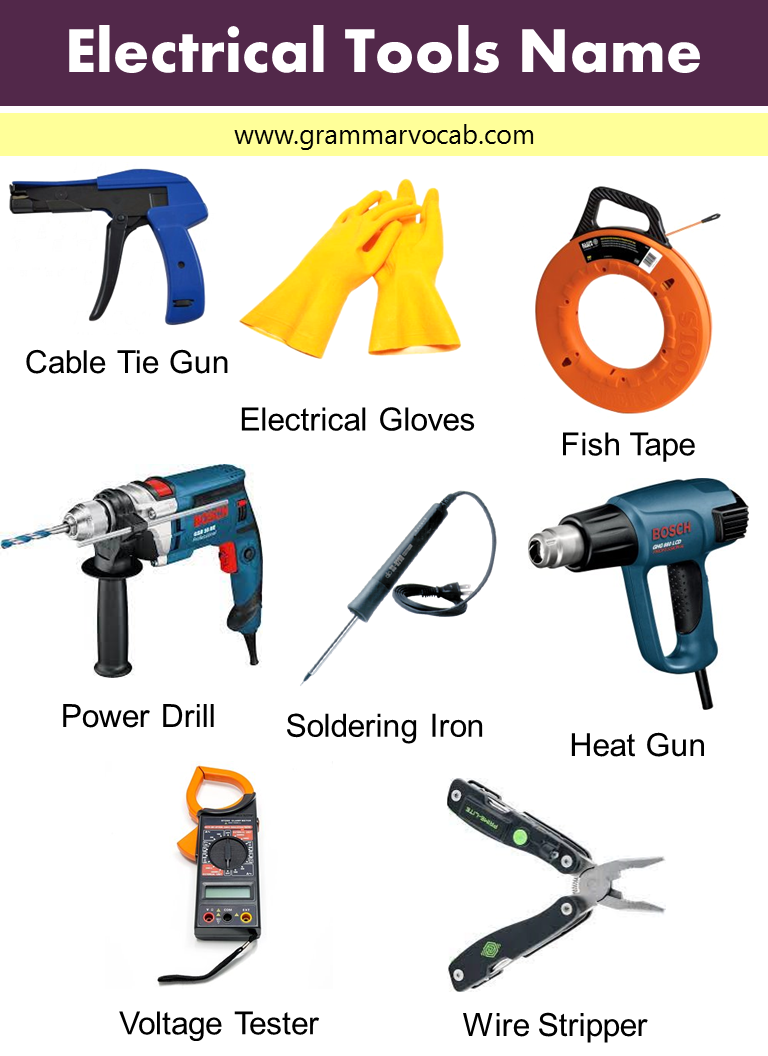
Agriculture Tools Name and Uses
Shovel – A tool used for digging and moving soil, sand, or other materials.
Hoe – A tool with a long handle and a flat blade used for breaking up soil, removing weeds, and shaping beds.
Rake – A tool used for leveling soil, removing debris, and preparing beds for planting.
Pruning Shears – A tool used for cutting small branches and trimming plants.
Hand Trowel – A small tool used for planting, digging, and weeding in tight spaces.
Wheelbarrow – A tool used for moving materials such as soil, mulch, and plants around a farm or garden.
Sprayer – A tool used for applying pesticides, herbicides, and other chemicals to crops.
Seed Drill – A machine used for planting seeds at a consistent depth and spacing.
Plow – A tool used for breaking up and turning over soil for planting.
Harrow – A tool used for smoothing soil, breaking up clumps, and preparing seedbeds.
Cultivator – A tool used for loosening soil, removing weeds, and preparing beds for planting.
Irrigation System – A system used for delivering water to crops for growth and hydration.
Grain Auger – A machine used for moving grain from one location to another, such as from a truck to a storage bin.
Hay Rake – A tool used for gathering and preparing hay for storage or transport.
Bale Spear – A tool used for moving and stacking hay bales.
Fence Post Driver – A tool used for driving fence posts into the ground.
Livestock Scale – A tool used for weighing livestock, such as cattle, pigs, and sheep.
Milking Machine – A machine used for extracting milk from cows, goats, or other dairy animals.
Animal Clippers – A tool used for trimming the hair or wool from animals, such as sheep or horses.
Grafting Tool – A tool used for joining two plants together to form a hybrid or improve the quality of the fruit.
Fruit Picker – A tool used for harvesting fruit from trees, such as apples or oranges.
Trencher – A machine used for digging trenches for irrigation, drainage, or utility lines.
Post Hole Digger – A tool used for digging holes for fence posts or planting trees.
Soil pH Tester – A tool used for measuring the acidity or alkalinity of soil for optimal plant growth.
Backpack Sprayer – A portable sprayer worn on the back, used for applying chemicals or fertilizers to crops.
Leaf Blower – A tool used for clearing leaves and debris from lawns, fields, or gardens.
Chainsaw – A tool used for cutting trees or branches into smaller pieces.
Wood Splitter – A machine used for splitting logs into smaller pieces for firewood.
Grain Dryer – A machine used for drying and preserving harvested grains.
Combine Harvester – A machine used for harvesting grain crops, such as wheat or corn.
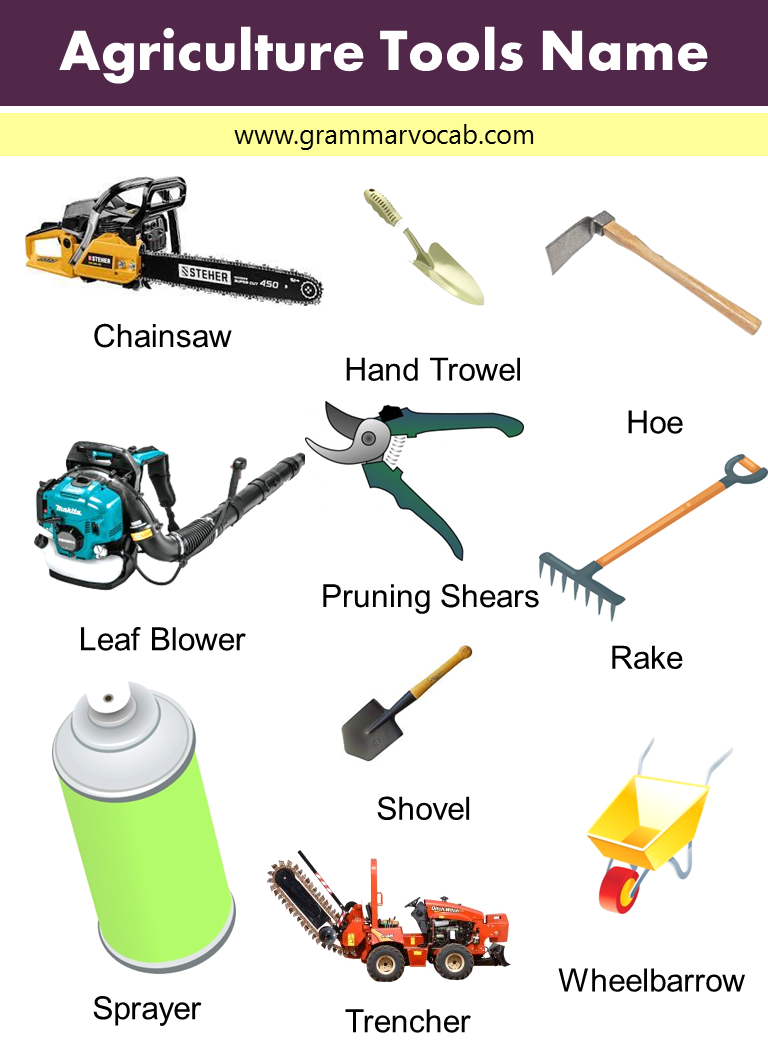
Carpenter Tools Name
Hammer – A tool used for driving nails or removing them from wood.
Screwdriver – A tool used for tightening or loosening screws in wood or other materials.
Chisel – A tool used for cutting and shaping wood or removing excess material.
Handsaw – A tool used for cutting wood, such as boards or planks.
Miter Saw – A tool used for making angled cuts in wood for precise corners and joints.
Circular Saw – A tool used for making straight cuts in wood, such as for framing or construction.
Jigsaw – A tool used for making curved or intricate cuts in wood or other materials.
Drill – A tool used for making holes in wood or other materials.
Router – A tool used for cutting and shaping wood or other materials for decorative or functional purposes.
Planer – A tool used for smoothing and shaping rough wood surfaces.
Level – A tool used for ensuring that surfaces are horizontal or vertical.
Square – A tool used for ensuring that corners and edges are square and true.
Tape Measure – A tool used for measuring distances, such as the length or width of wood.
Carpenter’s Pencil – A pencil used for marking measurements and lines on wood.
Nail Gun – A tool used for driving nails quickly and efficiently into wood or other materials.
Clamp – A tool used for holding wood or other materials in place while they are being worked on.
Wood Glue – An adhesive used for joining pieces of wood together.
Putty Knife – A tool used for applying and smoothing wood putty for repairing holes or imperfections in wood surfaces.
Wood Rasp – A tool used for shaping and smoothing wood surfaces.
Crowbar – A tool used for prying apart and removing boards or other materials.
Nail Set – A tool used for countersinking nails below the surface of wood.
Bradawl – A tool used for making small holes in wood for screws or nails.
Coping Saw – A tool used for cutting intricate shapes and patterns in wood.
Block Plane – A tool used for shaping and smoothing wood surfaces.
Spokeshave – A tool used for shaping and smoothing curves in wood.
Rafter Square – A tool used for marking and measuring angles and lengths for rafters in construction.
Dovetail Saw – A saw used for making precise cuts for dovetail joints.
Nail Puller – A tool used for removing nails from wood without damaging the surface.
Compass Saw – A saw used for cutting curves and shapes in wood.
Drawknife – A tool used for shaping and smoothing wood by hand.
Geometry Box Tools Name
A geometry box, also known as a math set, contains various tools used for drawing and measuring in geometry and other mathematical subjects. Here are some of the common geometry box tools and their uses:
Compass – A tool used for drawing circles and arcs of different sizes.
Divider – A tool used for measuring distances and transferring measurements from one place to another.
Protractor – A tool used for measuring angles in degrees.
Set square – A tool used for drawing straight lines and measuring angles.
Ruler – A tool used for measuring lengths and drawing straight lines.
Eraser – A tool used for erasing mistakes or unwanted marks on the paper.
Pencil – A tool used for drawing lines, marking points, and making calculations.
Sharpener – A tool used for sharpening pencils.
Compass Extension Bar – A tool used for drawing larger circles.
Parallel ruler – A tool used for drawing parallel lines.
French curve – A tool used for drawing smooth curves of different shapes.
T-square – A tool used for drawing horizontal and vertical lines and right angles.
Drafting brush – A tool used for cleaning eraser crumbs and other debris from the paper.
Technical pens – Pens with various tip sizes used for drawing precise lines.
Mechanical pencil – A pencil that uses replaceable leads, typically used for precise drafting.

Kitchen Tools Name
Chef’s Knife – A versatile knife used for chopping, slicing, and dicing a variety of ingredients.
Cutting Board – A flat surface used for cutting, chopping, and slicing ingredients.
Paring Knife – A small knife used for peeling and slicing small fruits and vegetables.
Bread Knife – A serrated knife used for cutting bread and other baked goods.
Kitchen Shears – Scissors used for trimming meat, poultry, and herbs, as well as opening packaging.
Grater – A tool used for shredding or grating cheese, vegetables, or other ingredients.
Vegetable Peeler – A tool used for peeling fruits and vegetables.
Measuring Cups and Spoons – Tools used for measuring ingredients accurately.
Mixing Bowls – Bowls used for mixing and preparing ingredients.
Colander – A bowl with small holes used for draining liquid from pasta, vegetables, and other ingredients.
Skillet – A frying pan used for cooking a variety of dishes, including eggs, meats, and vegetables.
Saucepan – A pot used for cooking sauces, soups, and other liquids.
Stockpot – A large pot used for making stock, soups, stews, and other large-batch dishes.
Baking Sheet – A flat pan used for baking cookies, pastries, and other baked goods.
Oven Mitts – Gloves used for handling hot pots, pans, and dishes.
Spatula – A tool used for flipping and turning foods, such as pancakes, eggs, and burgers.
Ladle – A tool used for serving soup, stew, or other liquid dishes.
Whisk – A tool used for beating and mixing ingredients, such as eggs, cream, and sauces.
Rolling Pin – A tool used for rolling out dough for pastries, cookies, and other baked goods.
Can Opener – A tool used for opening canned goods.

Tools Name in Garden
Hand Trowel – A small tool used for digging and planting in small areas.
Pruning Shears – A tool used for trimming and cutting small branches and stems.
Garden Fork – A tool used for digging and aerating soil.
Garden Spade – A tool used for digging and moving soil, compost, and other materials.
Garden Rake – A tool used for leveling soil, removing debris, and spreading mulch.
Hoes – A tool used for breaking up soil and removing weeds.
Garden Scissors – A tool used for trimming and shaping plants and bushes.
Hedge Trimmers – A tool used for trimming and shaping hedges.
Watering Can – A container used for watering plants and flowers.
Garden Gloves – Protective gloves used for working with soil, plants, and other materials.
Wheelbarrow – A tool used for transporting soil, mulch, and other materials around the garden.
Pruning Saw – A saw used for pruning and cutting larger branches and stems.
Garden Hose – A flexible tube used for watering plants and cleaning garden surfaces.
Garden Sprayer – A container used for spraying water, fertilizers, and other liquids on plants.
Leaf Rake – A tool used for collecting leaves and other debris from the garden.
Garden Kneeler – A cushioned pad used for kneeling and sitting while working in the garden.
Soil pH Tester – A tool used for measuring the acidity or alkalinity of the soil.
Bulb Planter – A tool used for planting bulbs, seeds, and small plants.
Garden Edging Tool – A tool used for creating clean borders around garden beds.
Garden Thermometer – A tool used for monitoring the temperature of the soil and air in the garden.
Garden Sprinkler – A tool used for watering a large area of the garden.
Garden Prong – A tool used for loosening soil, removing weeds, and planting bulbs.
Garden Hoe – A tool used for removing weeds, breaking up soil, and shaping the garden bed.
Garden Cultivator – A tool used for breaking up soil, removing weeds, and preparing soil for planting.
Garden Dibber – A tool used for making small holes in the soil for planting seeds or bulbs.
Garden Sickle – A tool used for cutting long grass or weeds.
Garden Auger – A tool used for drilling holes in the soil for planting trees, shrubs, or bulbs.
Garden Sprayer Gun – A tool used for spraying water, fertilizers, and pesticides on plants.
Garden Twine – A tool used for tying plants to trellises, stakes, or other support structures.
Garden Shovel – A tool used for digging, moving, and spreading soil, compost, or mulch.
Garden Leaf Blower – A tool used for removing leaves and debris from the garden and driveway.
Garden Hand Fork – A tool used for loosening soil, removing weeds, and transplanting seedlings.
Garden Kneeling Pad – A cushioned pad used for kneeling and sitting while working in the garden.
Garden Wire – A tool used for supporting plants, securing fences, and creating trellises.
Garden Saw – A tool used for cutting thick branches or stems of trees and shrubs.
These are some of the essential tools and equipment used in gardening. Different types of gardening tools and equipment are used for different purposes, such as planting, digging, pruning, and maintaining plants, flowers, and trees.
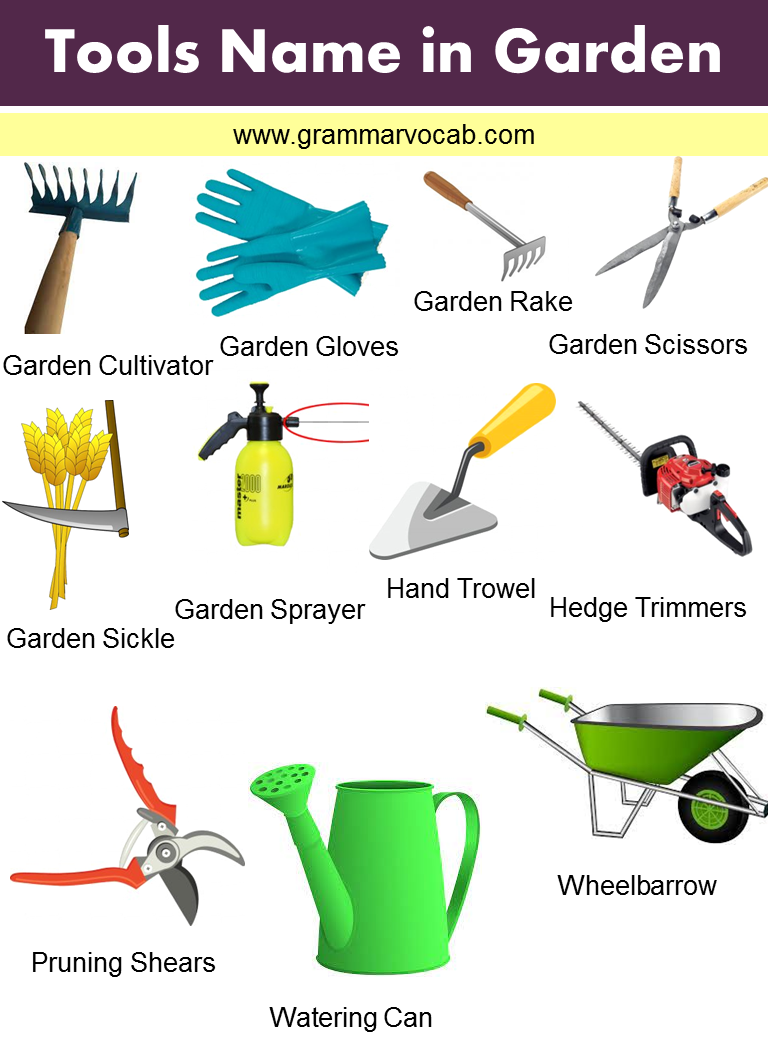
Mechanic Tools Names
Wrenches – Wrenches are used to tighten and loosen nuts and bolts. They come in different sizes and shapes such as open-end wrench, combination wrench, adjustable wrench, torque wrench, and pipe wrench.
Socket Set – Socket sets come with different sized sockets that can be attached to a ratchet handle. They are used for tightening or loosening bolts or nuts in tight spaces.
Screwdrivers – Screwdrivers come in various sizes and shapes and are used to turn screws. The most common types of screwdrivers include Phillips, flat-head, and hex screwdrivers.
Pliers – Pliers are versatile tools that can be used for gripping, bending, cutting, and pulling. They come in different types such as needle-nose pliers, slip-joint pliers, locking pliers, and diagonal pliers.
Pry Bars – Pry bars are used for prying open objects, removing nails, and lifting heavy objects. They come in different sizes and shapes.
Ratchets and Sockets – Ratchets and sockets are used for tightening or loosening nuts and bolts in hard-to-reach areas.
Wire Cutters – Wire cutters are used to cut wires and cables. They come in different sizes and shapes.
Power Tools – Power tools are used to perform a wide range of tasks such as cutting, drilling, sanding, and grinding. The most common types of power tools include drills, circular saws, jigsaws, angle grinders, and impact wrenches.
Toolboxes – Toolboxes are used to store and organize tools. They come in different sizes and shapes, and can be made of metal, plastic, or wood.
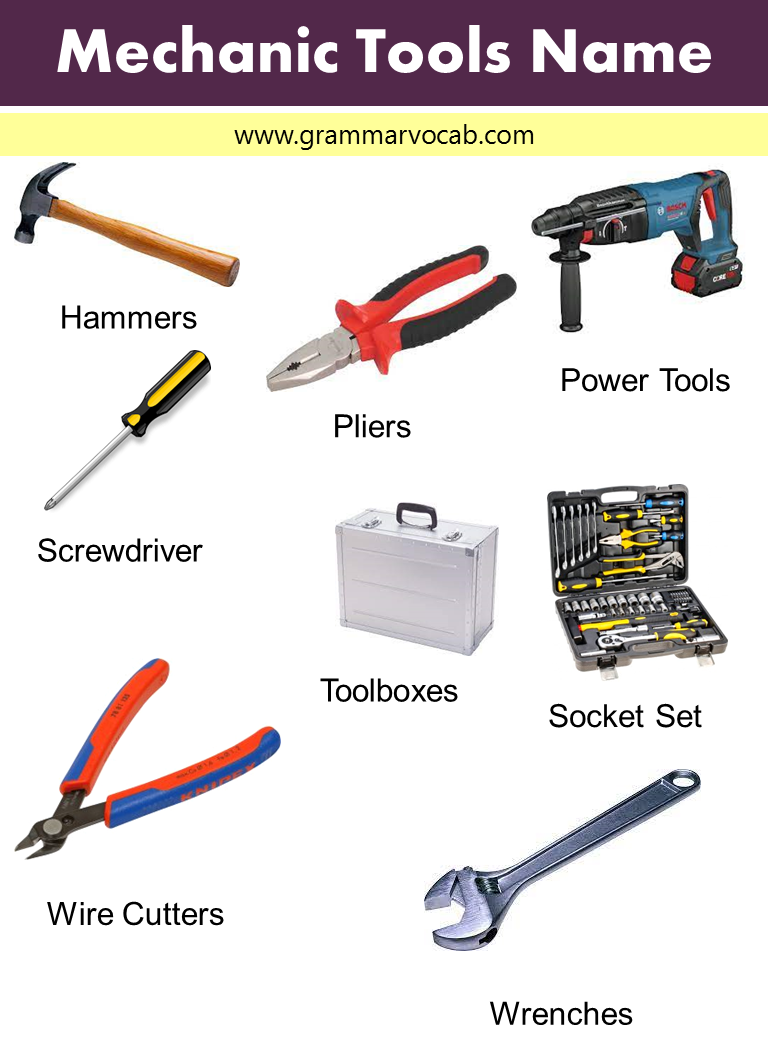
Tools Name for Construction
Hammer – Used for driving nails into wood or other materials.
Screwdriver – Used for turning screws and tightening or loosening bolts.
Wrench – Used for tightening or loosening nuts and bolts.
Pliers – Used for gripping and bending wires or other materials.
Saw – Used for cutting wood or other materials.
Drill – Used for making holes in wood, metal, or other materials.
Chisel – Used for shaping or carving wood or stone.
Level – Used for ensuring that a surface is level or plumb.
Tape measure – Used for measuring distances, lengths, and widths.
Square – Used for measuring angles and ensuring that corners are square.
Spirit level – Used for checking that surfaces are level.
Crowbar – Used for prying objects apart or lifting heavy objects.
Shovel – Used for digging holes, moving soil or other materials.
Wheelbarrow – Used for transporting materials.
Sledgehammer – Used for breaking up concrete or other heavy-duty demolition work.
Power saw – Used for cutting through materials with precision and speed.
Power drill – Used for making holes in tough materials quickly and easily.
Grinder – Used for grinding and cutting metal or other hard materials.
Welding torch – Used for welding metal together.
Crane – Used for lifting and moving heavy objects on a construction site.



